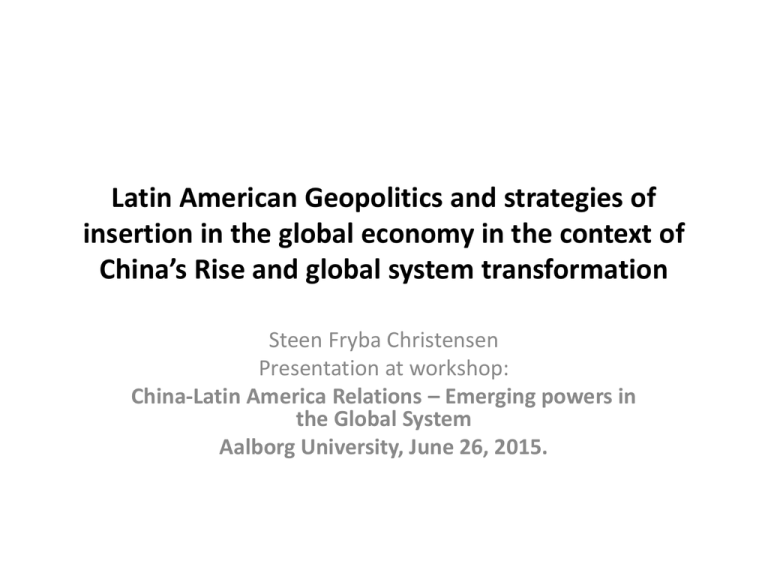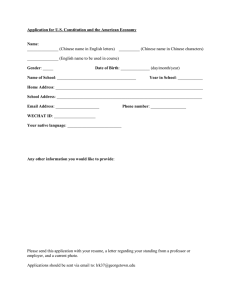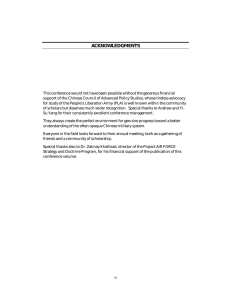China Latin America Relations Aalborg June 2015
advertisement

Latin American Geopolitics and strategies of insertion in the global economy in the context of China’s Rise and global system transformation Steen Fryba Christensen Presentation at workshop: China-Latin America Relations – Emerging powers in the Global System Aalborg University, June 26, 2015. China’s Rise: Centripetal or Centrifugal tendencies? • In the context of the 1990’s: Centripetal tendencies in Latin America. • • • • ”Open regionalism”. Insertion focus on US/OECD/North. Economic orthodoxy. Search for ”credibility”. • China (India) rises but remains ”small” China’s Rise: Centripetal or Centrifugal tendencies? • In the context after year 2000/2003: Centrifugal tendencies in Latin America. • ”Post-neoliberal” regionalisms emerge alongside ”open regionalism” • Insertion focus: Diversification (mainly) • Economic orthodoxy or heterodoxy • Search for ”autonomy” (and influence) • China (India) becomes ”big”/rises. Analyzing China-Latin America Relations: Comparative approach • Creation of three ”typologies” for comparison • Brazil, Venezuela and Chile represent typologies. • • • • Three criteria for typology creation: 1. Economic orthodoxy/heterodoxy. 2. Economic model (production profile). 3. Foreign policy orientation (regionalisms) Typology 1 • Venezuela: • 1. Heterodoxy (with orthodox elements) • 2. Natural ressource based economy with ”monocultural” tendencies (oil dependency) • 3. Aim of autonomy through diversification, multipolarization. Anti-US/imperialism. SouthSouth alliances. ALBA, Unasur, CELAC, Mercosur, OPEC (including several ”anti-US” governments), China. Typology 2 • • • • Brazil 1. Heterodoxy and orthodoxy combined. 2. Diversified economy 3. Aim of autonomy through diversification, multipolarization. Influence. South-South alliances. Unasur, Mercosur, CELAC, China, BRICS, Global player included in the top of the global hierarchy + regional leadership. Typology 3 • Chile • Economic orthodoxy with a ”social orientation”. • Intermediate economic model based largely on natural resources of different sorts. Value-adding. • Autonomy. Diversification through a liberal strategy with a strong focus on economic dimension (USA, EU, China, South Corea, Mercosur, Israel etc. etc. etc.). Unasur, CELAC, Pacific Alliance, Trans Pacific Partnership. Typologies • 1. Includes Bolivia and Ecuador. • 2. Partially includes Argentina. • 3. Includes Colombia and Peru • Mexico and Central America fall somewhat outside of the typologies. Mexico will be drawn into the analysis through comparisons with category 2 and 3, though Mexico is specialized in manufacturing production. Analysis from Chinese and Latin American perspectives • In terms of the economic dimension, ChinaLatin American relations follow relatively clear patterns. • The analysis will mainly focus on the economic dimension. Chinese perspective • China’s interest: 1. Natural resources/commodities imports. Oil is particularly prioritized (Metals, food, foodstuff). • 2. Export markets for Chinese manufacturing. Chinese • 3. FDI (from 2010 mainly). Mainly in prioritized natural goods sectors and in infrastructure and energy. Also some interest in manufacturing sector. This interest is likely to rise. Chinese perspective • Interest particularly directed at: Brazil, Argentina, Chile, Venezuela, Ecuador. • Geopolitical aspect: BRICS. Good relations with Latin America and Caribbean (Africa) (etc.). Avoid barriers for China’s economic rise. Basis for potential regional hegemony (Asia) and influence in other regions. Reduce US/Western power superiority (”shared order). Typology based comparative analysis of Latin American perspectives • Rise of China, Great peripheral countries, the South provides a better international context for ”autonomy”/room of maneuver. • 2000s debate on ”winners” and ”losers”: South America vs. Mexico and Central America. • Huge challenge for Mexico and Central America as their economic models are not very ”complementary” to China’s economic model. Competitive pressure. Analysis • For South America ”complementary” aspects of economic models: China demands primary sector imports. Significant improvements in terms of trade for typology 1, 2 and 3 countries allow for economic dynamism and economic stabilization + reduced external economic vulnerability. • Context of ”optimism” in typology 1, 2 and 3 countries in South America between 2000/2003 and 2008. Analysis • Some critical voices (particularly from industry, and academia). The nature of the ”Chinese system” of state/business coop. Danger of ”de-industrialization” and ”re-commodification” (particularly Brazil; and Argentina). Some ”sino-phobia” as in Mexico. • 2009-2013. Optimism and China-enthusiasm is largely maintained. However, growing discontent with North/South aspects of economic relations with China. Hopes for the future – FDI. • 2013-2015. Hopes and desorientation. Search for new strategies + for reducing external economic vulnerabilities. Growing dependency of China, particularly in typology 1 (2) Analysis • Typology 1: Venezuela (Ecuador). Economic instability (negative growth, high inflation). Negative growth in Venezuela. Cut-backs in public spending. • China as ”lender of last resort”. Venezuela facing deep problems from domestic and external sides. • Domestic economic instability – political instability. • US sanctions policy towards Venezuela. Attempt at destabilizing the Venezuelan regime. US strategy of reasserting its regional leadership position. • Venezuela: weakness and high level of external economic vulnerability. Question: Stability of Chinese financial support? Hoping for Chinese FDI and financing. Analysis • Typology 2: Brazil faces economic stagnation and growing domestic political discontent. • Re-assessment of strategy of economic insertion in the global economy. Looking more towards the North again – US, EU etc. • How can ”we” export more and strengthen the manufacturing sector? • Cut-backs in public spending due to economic stagnation. • Hopes for Chinese FDI. (Mexico does not face a similar problem. Still challenged by Chinese manufacturing sector competition. Hopes for Chinese FDI; oil sector ”opening”) Analysis • Typology 3: Chile (Colombia and Peru). • Chile faces the more adverse international context with ”volatility” in prices of commodity exports. • It is more economically stable, with stronger foundations. • The enigma of ”missing” Chinese FDI in Chile. Hopes for more FDI from China. (Mexico hopes for FDI, too). Final observations • For China the main typolocy category of relevance for Chinese interests is category 2 – ”economic model”. • Category 1 – economic strategy and category 3 – foreign policy are not very important for China. Final observations • For Latin America category 1 countries face major economic challenges of dependency/vulnerability. Category 2 countries also face such challenges, but to a smaller extent. Category 3 countries are more stable but do face challenges from adverse ”terms of trade”. • Mexico and Central America face continued challenges from Chinese competition. • At the moment all categories want more Chinese FDI. • If this situation persists I would expect re-orientations in development strategies (economic/foreign policy).





